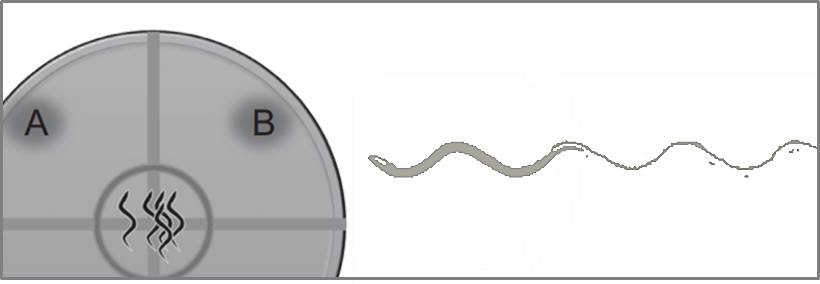
Chemotaxis is a fundamental biological process, whereby organisms move towards or away from a particular chemical stimulus. The nematode Caenorhabditis elegans is well-known for its remarkable ability to navigate towards food sources and locate potential mates using a highly sensitive chemotaxis response. This behavior has been extensively studied in neuroscience as it provides a simple yet powerful system to investigate the mechanisms underlying learning and memory.
The WMicrotracker ARENA system offers a powerful tool for investigating chemotaxis behavior in real-time. The system provides a wealth of data on the distribution of worm populations within plate quadrants, as well as the kinetics of the Chemotaxis Index over time.
Jemil Ahmed, in his thesis “Inhibitors of Alpha-Synuclein Aggregation” (November 2022, advisor: Sunil Kumar), utilized the WMicrotracker ARENA system to investigate the effect of Ops (Oligopyridylmides) on behavioral deficits in UA196 worms. In C. elegans, a lack of dopamine synthesis in DA neurons leads to behavioral deficits, such as impaired food sensing behavior. Over time, the DA neurons in UA196 worms degenerate, resulting in a decrease in dopamine levels. Ahmed evaluates one Ops, the compound NS163, to rescue the degeneration of DA neurons and investigated its effect on the worms’ behavior.
For the experiments, Ahmed divided a petri dish is into four quadrants (Figure 1), where two opposite quadrants were treated with a toxic chemical (ethanol, repellent – red dots) or food (E. coli, movement deterrent – green dots) for worms. The chemotaxis index (CI) of 50 worms placed at the center of the dish was measured using the WMicrotracker ARENA.

On day three of adults, the kinetic data for the CI showed that all worms spent most of their time in the E. coli quadrants (Figure 2A). None of the worms displayed behavioral deficits, observing a similar behavioral response of UA196 and N2 worms. In concordance, all the DA neurons in UA196 worms were intact.
In marked contrast, on day 10, the kinetics of the CI of UA196 did not display any preference for ethanol or E. coli for the whole time course of the experiment (Figure 2B), indicating the behavioral deficits caused by the degeneration of DA neurons. However, the UA196 worms treated with NS163 strongly favored E. coli than ethanol, similar to the control worms, indicating that NS163 was able to rescue the behavioral deficits of UA196.

The results of Ahmed’s study suggest that NS163 may be a potential therapeutic agent for the treatment of Parkinson’s disease, a disorder characterized by the degeneration of dopamine-producing neurons.
In summary, the WMicrotracker ARENA system is a powerful tool for studying the behavior of C. elegans and investigating the effects of different compounds on their behavior. Ahmed’s study highlights the potential of this system for identifying new therapeutic agents for the treatment of neurological disorders.
Ahmed, Jemil, “Inhibitors of Alpha-Synuclein Aggregation” (2022). Electronic Theses and Dissertations. 2095.
https://digitalcommons.du.edu/etd/2095
